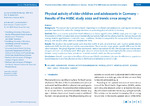Physical activity of older children and adolescents in Germany – Results of the HBSC study 2022 and trends since 2009/10
Bucksch, Jens
Möckel, Juliane
Kaman, Anne
Sudeck, Gordon
Background: Physical activity is central to health, beginning in childhood and adolescence, and regular monitoring provides important information for strategic decisions on promoting physical activity in Germany.
Methods: The current survey cycle of the Health Behaviour in School-aged Children (HBSC) study gives an insight into the prevalence of the indicators daily recommended physical activity, high and low physical activity, and sporting activity among students aged between 11 and 15 for 2022. In addition, the data is compared to the survey cycles of the 2009/10, 2013/14, and 2017/18 school years and analysed over time.
Results: The results of the current survey cycle show that 10.8 % of girls, 20.9 % of boys, and 12.4 % of gender diverse adolescents fulfil the daily physical activity recommendation. There are also major gender-specific differences for the other indicators. The group of gender diverse adolescents needs to be analysed further. The changes over time between 2009/10 and 2022 are relatively small. While girls' physical activity habits decreased slightly for the various indicators between 2009/10 and 2022, boys' prevalence remained relatively stable over the same period.
Conclusions: Overall, in part due to the effects of the various COVID-19 lockdowns, the need for effective and population-based measures to promote physical activity in childhood and adolescence remains high.
Dateien zu dieser Publikation

